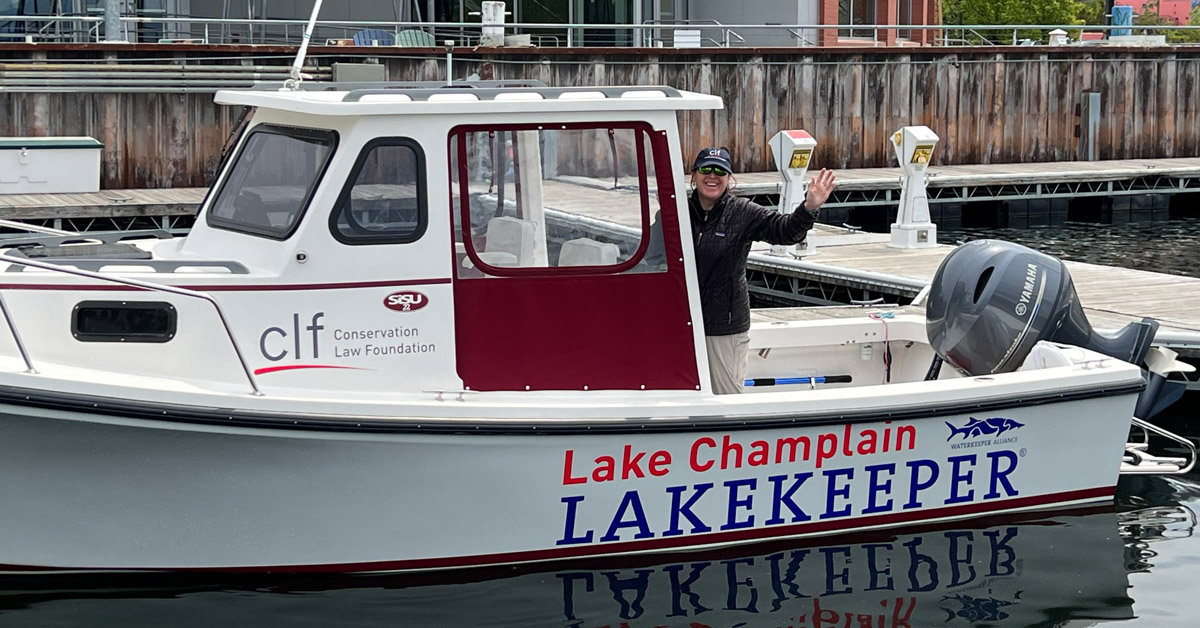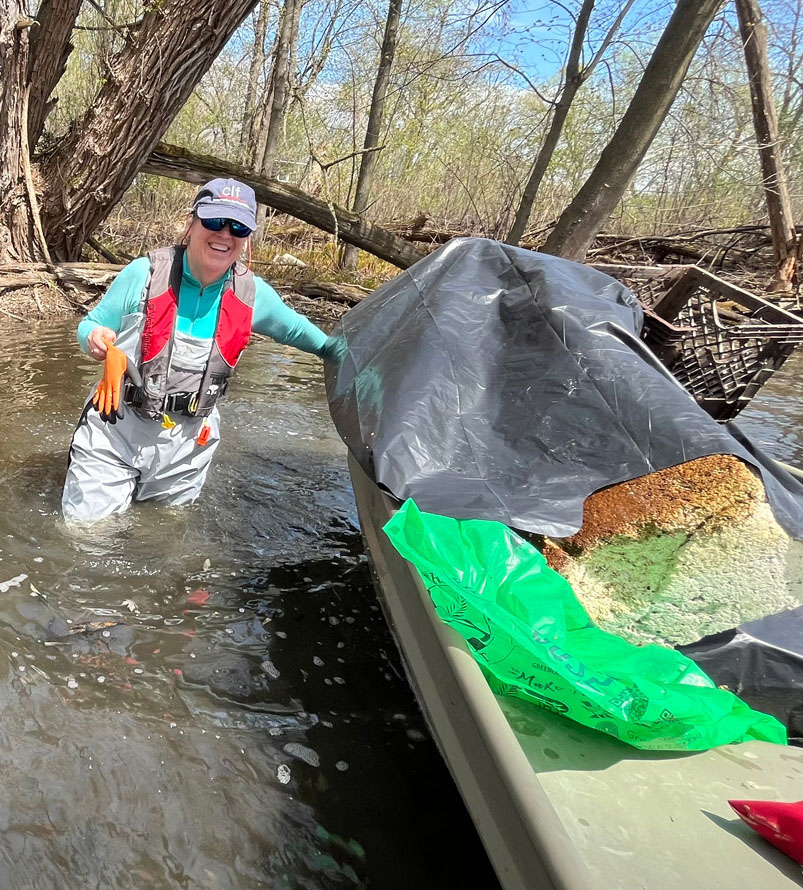The lakekeeper of Lake Champlain

Julie Silverman ’87 promotes environmental stewardship overseeing New England’s largest lake
Julie Silverman ’87 describes herself as a Lorax of Lake Champlain. She is, she says, its eyes, ears, heart and sometimes its voice.
Her actual title Lake Champlain senior lakekeeper for the Conservation Law Foundation; her mission is to protect it as a precious natural resource through public outreach, public policy and science-based field work.
Silverman grew up in Essex, Vt., less than 10 miles east of Burlington, and spent much of her youth participating in water sports. Now, she patrols the lake in a motorboat emblazoned with her title, testing water and collecting and analyzing debris dumped into the lake through the tributary rivers. She also teaches local students how to care for the lake and enjoys taking stakeholders out on the water to show them why she cares so deeply about its health, while encouraging others to do the same.
“I work with an amazing legal advocacy team in Vermont and throughout New England,” Silverman explained. “We work hard every day, especially during the current White House administration, to fight for the health of our communities and the environment.”
The largest lake in New England, Lake Champlain stretches for 120 miles between Whitehall, N.Y. and the Richelieu River in Québec, with 239 towns in its watershed—the lands that drain into it. Many factors have made it a challenging body of water to keep clean. Rising chloride levels, cyanobacteria blooms, non-native invasive species and three pollution-dumping floods in 2023–24 threaten the lake’s fish and wildlife, as well as the lives of more than 160,000 individuals who rely on it for drinking water.
With such a massive area to cover, measuring the progress of her efforts takes patience.
“There are tiny wins almost every day, and I can contribute to a larger, long-term data set and look at incremental changes [in water quality and debris removal], but a lot of these issues require determination and years and advocacy to move the needle from a policy and legislation perspective,” Silverman said. “That’s where we can make change.”

Her efforts have resulted in some recent policy wins, including the outlawing of unencapsulated foam dock flotations—but foam coolers, bait containers and meat trays remain legal in Vermont, whereas foam cups, plates and takeout containers were banned in 2020. There is always more work to do.
Enforcing the laws requires follow-through and patience, she says. “Just because it’s been put into law doesn’t mean it’s a done deal, as we see rollbacks, cutbacks and people pushing out timelines and amending laws. So you just have to keep fighting.”
Silverman earned a bachelor’s degree in biology at Wheaton, where she felt empowered by many female faculty members and enjoyed studying in small classes, getting to know professors and taking a wide variety of courses.
“It felt like most of my classmates were either pre-med or pre-dental, but I used to say ‘I’m just pre-life.’”
She served as a lifeguard on campus and was especially influenced by biology professors Lisa Floyd-Hanna, Ed Tong and Betsy Dexter Dyer, who encouraged an independent study with professors at St. Michael’s College, fulfilling Silverman’s desire to study newts for her senior thesis. “I created a proposal and Wheaton helped create a space to do that,” she said.
Through a junior exchange program, Silverman also took classes for the year at Williams College, which she referred to as “a great opportunity” that confirmed her preference for the smaller class sizes and personal attention she received at Wheaton.
One of the best takeaways from her Wheaton experience was the lasting friendships she created with several classmates, including Leslie Boerner Neville ’87, who became one of her best friends. Silverman explained, “When you study the sciences together, and share your ups and downs, it creates a pretty strong bond.”
After graduating, she found that she did not enjoy the work of her first job at a big Boston law firm, and volunteered at the New England Aquarium while earning a master’s degree in science education from Tufts University. She worked at the Boston Museum of Science, where she gained experience handling many animals and teaching a wide variety of science topics. She brought this experience into her work in public school where she worked for a couple of years.
“I had such an amazing opportunity to work at two world-renown destinations and when I went to museum conferences with folks from around the world I wondered why we didn’t have anything like that where I grew up.”
Fueled by that awakening, Silverman was determined to address it. Burlington was working to improve its waterfront and build a science center. She saw an opportunity.
“Just because we’re a small community doesn’t mean that we don’t deserve world class experiences, education, teaching and opportunities to learn and discover,” she said.
Silverman was the first employee hired at the new science center built on the Burlington shore of the lake in 1995, and spent 20 years fulfilling its mission to “inspire and engage families in the joy of scientific discovery, wonder of nature and care of Lake Champlain.” The center is now the ECHO Leahy Center for Lake Champlain.
“I reestablished myself in a community that I grew up in, but had obviously changed,” she said. “Bringing that experience home, and then sort of launching it on its way, was a big deal and it was exciting to be able to do that.”

Silverman is thrilled to continue to serve as an educator and steward of Lake Champlain in her current role. “I contribute on the science side. But a large part of my work is advocacy and talking to people and understanding communities,” she explained. “My liberal arts education has really served me well. It makes it easier to talk to legislators. If you have a broad background, you can find more commonalities.”
Not one to idle, Silverman also enjoys the winter. When she puts the boat away for the season, she grabs her gear and heads for the mountains, where she has been teaching others how to ski for 25 years.
“I tell people from summit to shore, I’m on water wherever I go,” she mused. “Whether it’s solid, liquid or gas, sign me up.”
